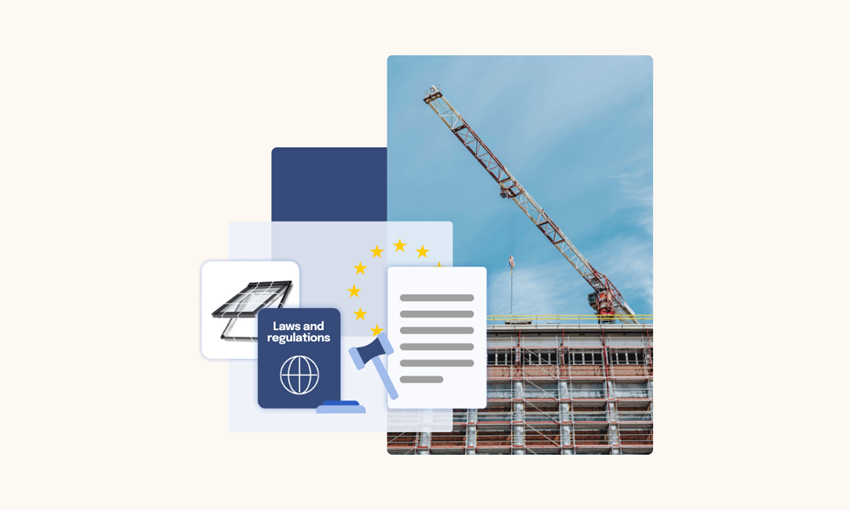2025 tradeshow highlights: BIMobject year-in-review
Discover key BIM trends from BIMobject’s 2025 event year insights from global tradeshows, digital workflows, sustainability talks, and manufacturer adoption.
Are you ready for the sweeping changes coming to the construction industry in the European Union? The EU’s ambitious push toward sustainability has introduced a series of regulations impacting how buildings are designed, constructed, and maintained. For building product manufacturers, these regulations create new demands from architects, specifiers, and developers who need compliant solutions to meet their obligations. We'll provide a clear overview of these regulations, your compliance obligations, and timelines for implementation. By the end, you'll better understand how these affect your operations and how to adapt your business strategies accordingly.

This blog is an excerpt from our EU Sustainability Laws and Data Regulations eBook. Want to read the complete guide? Download it here.
The construction industry is a significant contributor to global environmental challenges. Buildings account for approximately 40% of the EU’s total energy use and 36% of its greenhouse gas emissions. Additionally, construction generates a large share of waste and consumes enormous amounts of raw materials.
To address these issues, the European Union has committed to becoming the first climate-neutral continent by 2050. Regulations are emerging to:
These policies create both challenges and opportunities. Compliance is necessary, as architects and construction professionals demand sustainable products to meet project requirements and regulatory mandates.
What is it?
The EU Taxonomy Regulation is a critical component of the European Union's sustainable finance agenda, providing a unified classification system for environmentally sustainable economic activities. It defines clear criteria for activities aligned with a net-zero trajectory by 2050 and broader environmental goals, including climate, pollution, and biodiversity. The regulation is designed to guide investments toward sustainable projects, helping the EU meet its climate-energy targets for 2030 and achieve the objectives of the European Green Deal.
Construction activities, including development, renovation, and materials manufacturing, must align with six objectives: climate change, water management, circular economy, pollution prevention, and biodiversity.
Who must comply?
Large construction, manufacturing, and real estate companies must comply if they meet employee, revenue, or asset thresholds. Financial institutions covered by the Non-Financial Reporting Directive must also report on sustainable investments aligned with the Taxonomy.
When to comply?
Compliance with the EU Taxonomy began in January 2022 for climate-related criteria, with additional environmental objectives now fully in effect as of 2024.
Prodikt helps you manage and report on the key sustainability criteria required by the EU Taxonomy and other regulations. Learn how Prodikt can support your compliance efforts here.
What is it?
The Construction Products Regulation (CPR) harmonizes EU rules for marketing construction products, facilitating their free movement within the single market. It aims to reduce administrative burdens and promote circular economy principles by integrating Digital Product Passports (DPPs) and Environmental Product Declarations (EPDs). The CPR updates existing legislation to align with technological advancements and environmental objectives.
The CPR aims to provide clear, reliable information about the performance of construction products. It establishes a common technical language, ensuring that all products meet the required safety, health, and environmental standards. To guarantee consistency and quality, construction products sold in Europe must carry the CE mark, which indicates compliance with these regulations. This ensures that products meet high standards and are safe to use across the EU market. The CPR applies to all construction products on the EU market, including materials, components, and systems used in building and civil engineering works.
Who must comply?
All entities involved in producing, importing, and distributing construction materials and products. The regulation mandates the development of DPPs and EPDs for all 430,000 relevant companies active in Europe today.
When to comply?
The European Union Council officially adopted the CPR on November 5, 2024. It is expected to become active after its signature, marking the commencement of compliance obligations for all relevant stakeholders.
What is it?
The Corporative Sustainability Reporting Directive (CSRD) is a European Union regulation that requires large companies and all listed companies to report on their environmental, social, and governance (ESG) impacts. It builds on the Non-Financial Reporting Directive (NFRD) to establish stricter, more comprehensive sustainability reporting standards. The CSRD aims to provide stakeholders with transparent and comparable data on company operations to encourage sustainable business practices across all sectors.
CSRD applies broadly to companies across the EU, regardless of the industry. Companies must report on their sustainability practices, impacts, and risks, covering a range of ESG factors such as greenhouse emissions, resource use, social responsibility, and governance. The CSRD’s reporting standards are set by the European Sustainability Reporting Standards (ESRS), ensuring consistent ESG data across industries. It encompasses around 50,000 large enterprises and all publicly listed companies within the EU.
Who must comply?
Companies that meet two of the following criteria: 250+ employees, €40 million+ in turnover, or €20 million+ in assets. This requirement applies to listed companies and extends reporting obligations to all sectors.
When to comply?
The CSRD took effect in January 2024, with the first reports expected in 2025. This phased timeline allows companies to prepare for comprehensive reporting requirements.
How EandoX helps you meet CSRD requirements
EandoX makes it easier to meet CSRD requirements by offering an integrated platform that simplifies the collection and reporting of sustainability data. With accurate, up-to-date data from your supply chain, EandoX ensures you can report confidently without the need for repeated check-ins with suppliers. The platform allows suppliers to enter data directly, and any updates automatically flow through your product catalog, keeping your reports accurate and consistent.
See how EandoX simplifies your sustainability reporting process
What is it?
Digital Product Passports (DPPs) are electronic records that contain detailed, standardized information about a product's lifecycle, including materials, origin, manufacturing processes, environmental impact, and recycling information. They enable stakeholders, including manufacturers, distributors, and end users, to access reliable data about the product's sustainability and compliance. DPPs are a key enabler of the circular economy by facilitating the tracking of products and materials through their entire lifecycle.
DPPs will be mandatory for various products, including construction materials and building products. They are designed to provide transparent, verifiable data that supports sustainability, resource efficiency, and product reuse. DPPs help improve product traceability from manufacturing to disposal, ensuring that materials can be efficiently recycled or reused, in line with the EU's waste reduction and circular economy goals.
Who must comply?
Manufacturers, distributors, and importers of goods sold in the EU. The regulation will impact large and small companies with different compliance timelines based on product category and market size.
When to comply?
A rollout was anticipated in 2024, starting with key product categories. It will be followed by gradual implementation by 2026, with full compliance expected by 2027.
Want to learn more about Digital Product Passports? Deep dive into our blog.
What is it?
The Carbon Border Adjustment Mechanism (CBAM) is an EU regulation that prevents carbon leakage by placing a carbon price on imported goods from countries with lower environmental standards. It ensures that imports from carbon-intensive industries, such as steel, cement, aluminum, and electricity, are subject to the same carbon costs as goods produced within the EU. By leveling the playing field for EU businesses, CBAM encourages global decarbonization and aligns international trade with the EU's climate goals, promoting lower emissions and higher environmental standards worldwide.
Who must comply?
It applies to EU importers of carbon-intensive goods, including cement, iron and steel, aluminum, fertilizers, and electricity. These businesses are required to report the embedded carbon emissions of their imported products.
When to comply?
CBAM began with emissions reporting in 2023, with full implementation by 2026, requiring importers to buy carbon certificates for their goods.
How EandoX can help with CBAM
EandoX provides a way for businesses to track and report the carbon emissions in imported goods, making sure you're fully prepared with CBAM regulations.
Need a smoother path to CBAM compliance? Discover how EandoX can help

Mattias Steinbichler, BIMobject’s Group Director of Expansion & Data Partnerships, explains:
"Regulations like the EU Taxonomy and CPR make sustainability and transparency non-negotiable. Building product manufacturers that digitize their product data and provide detailed compliance information will have a clear advantage in the market."
Sebastiaan Stiller, CEO of EPD International, highlights in our latest documentary the growing impact of regulations:
"The construction sector is responsible for 40% of the world’s CO₂ emissions. The industry has committed to quite ambitious targets. EPDs or LCAs can be used to improve your products over time and to comply with regulations. With regulations coming into place, they are formalizing the need for how to integrate sustainability into decision-making. The necessity to report will only increase."
Discover how Bim.com is leading a sustainable, efficient transformation in our latest CBS Documentary.
Regulations are getting stricter, sustainability reporting is growing, and the amount of product data you need to manage keeps increasing. We get it - building today is more complex than ever.
That’s where Bim.com, the umbrella brand behind BIMobject, Prodikt, and EandoX, comes in. We give you accurate, reliable product data to meet regulatory requirements.
With Bim.com, your data is accessible, accurate, and up to standard. We make it easier to keep up with regulations and get your products in front of your customers.
Ready to build better? Explore what we can do for you at Bim.com.
Discover key BIM trends from BIMobject’s 2025 event year insights from global tradeshows, digital workflows, sustainability talks, and manufacturer adoption.
See how architects and engineers find products and what information they trust. Use these insights to shape your 2026 marketing plan.
Learn how BIM influences product selection and what makes specifiers choose one brand over another. Insights from BIMobject’s expert interview.